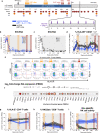IL-21 and IFNα therapy rescues terminally differentiated NK cells and limits SIV reservoir in ART-treated macaques
- PMID: 34001890
- PMCID: PMC8129202
- DOI: 10.1038/s41467-021-23189-7
IL-21 and IFNα therapy rescues terminally differentiated NK cells and limits SIV reservoir in ART-treated macaques
Abstract
Unlike HIV infection, which progresses to AIDS absent suppressive anti-retroviral therapy, nonpathogenic infections in natural hosts, such African green monkeys, are characterized by a lack of gut microbial translocation and robust secondary lymphoid natural killer cell responses resulting in an absence of chronic inflammation and limited SIV dissemination in lymph node B-cell follicles. Here we report, using the pathogenic model of antiretroviral therapy-treated, SIV-infected rhesus macaques that sequential interleukin-21 and interferon alpha therapy generate terminally differentiated blood natural killer cells (NKG2a/clowCD16+) with potent human leukocyte antigen-E-restricted activity in response to SIV envelope peptides. This is in contrast to control macaques, where less differentiated, interferon gamma-producing natural killer cells predominate. The frequency and activity of terminally differentiated NKG2a/clowCD16+ natural killer cells correlates with a reduction of replication-competent SIV in lymph node during antiretroviral therapy and time to viral rebound following analytical treatment interruption. These data demonstrate that African green monkey-like natural killer cell differentiation profiles can be rescued in rhesus macaques to promote viral clearance in tissues.
Conflict of interest statement
The authors declare no competing interests.
Figures





Similar articles
-
Short-Term Pegylated Interferon α2a Treatment Does Not Significantly Reduce the Viral Reservoir of Simian Immunodeficiency Virus-Infected, Antiretroviral Therapy-Treated Rhesus Macaques.J Virol. 2018 Jun 29;92(14):e00279-18. doi: 10.1128/JVI.00279-18. Print 2018 Jul 15. J Virol. 2018. PMID: 29720521 Free PMC article.
-
Increased Proviral DNA in Circulating Cells Correlates with Plasma Viral Rebound in Simian Immunodeficiency Virus-Infected Rhesus Macaques after Antiretroviral Therapy Interruption.J Virol. 2021 Feb 24;95(6):e02064-20. doi: 10.1128/JVI.02064-20. Print 2021 Feb 24. J Virol. 2021. PMID: 33408173 Free PMC article.
-
SMAC Mimetic Plus Triple-Combination Bispecific HIVxCD3 Retargeting Molecules in SHIV.C.CH505-Infected, Antiretroviral Therapy-Suppressed Rhesus Macaques.J Virol. 2020 Oct 14;94(21):e00793-20. doi: 10.1128/JVI.00793-20. Print 2020 Oct 14. J Virol. 2020. PMID: 32817214 Free PMC article.
-
Brain macrophages harbor latent, infectious simian immunodeficiency virus.AIDS. 2019 Dec 1;33 Suppl 2(Suppl 2):S181-S188. doi: 10.1097/QAD.0000000000002269. AIDS. 2019. PMID: 31789817 Free PMC article. Review.
-
Walk on the wild side: SIV infection in African non-human primate hosts-from the field to the laboratory.Front Immunol. 2023 Jan 12;13:1060985. doi: 10.3389/fimmu.2022.1060985. eCollection 2022. Front Immunol. 2023. PMID: 36713371 Free PMC article. Review.
Cited by
-
Interleukin-21 in Viral Infections.Int J Mol Sci. 2021 Sep 1;22(17):9521. doi: 10.3390/ijms22179521. Int J Mol Sci. 2021. PMID: 34502427 Free PMC article. Review.
-
Plus-strand RNA viruses hijack Musashi homolog 1 to shield viral RNA from cytoplasmic ribonuclease degradation.J Virol. 2025 Mar 18;99(3):e0002325. doi: 10.1128/jvi.00023-25. Epub 2025 Feb 12. J Virol. 2025. PMID: 39936918 Free PMC article.
-
A genetic fingerprint associated with durable HIV remission after interruption of antiretroviral treatment: ANRS VISCONTI/PRIMO.Med. 2025 Aug 8;6(8):100670. doi: 10.1016/j.medj.2025.100670. Epub 2025 Apr 28. Med. 2025. PMID: 40300610
-
A yeast expressed RBD-based SARS-CoV-2 vaccine formulated with 3M-052-alum adjuvant promotes protective efficacy in non-human primates.Sci Immunol. 2021 Jul 15;6(61):eabh3634. doi: 10.1126/sciimmunol.abh3634. Sci Immunol. 2021. PMID: 34266981 Free PMC article.
-
New Latency Reversing Agents for HIV-1 Cure: Insights from Nonhuman Primate Models.Viruses. 2021 Aug 6;13(8):1560. doi: 10.3390/v13081560. Viruses. 2021. PMID: 34452425 Free PMC article. Review.
References
-
- Houchins JP, et al. Natural killer cell cytolytic activity is inhibited by NKG2-A and activated by NKG2-C. J. Immunol. 1997;158:3603–3609. - PubMed
Publication types
MeSH terms
Substances
Grants and funding
LinkOut - more resources
Full Text Sources
Other Literature Sources
Molecular Biology Databases

